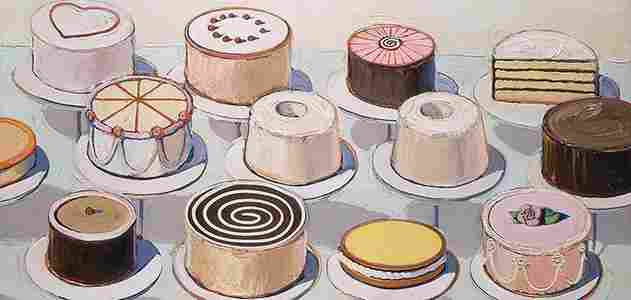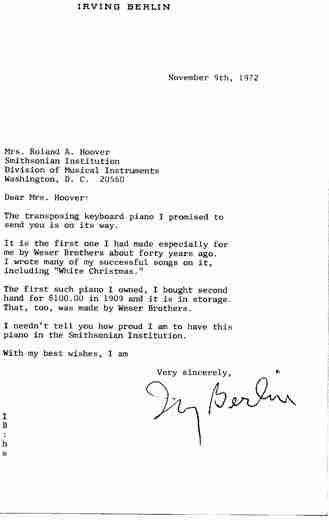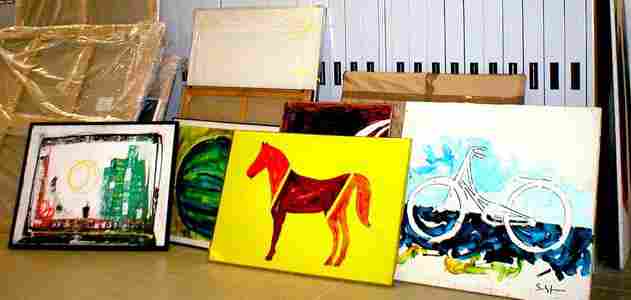Wayne Thiebaud Is Not a Pop Artist

Among the familiar Wayne Thiebaud paintings on display at the Crocker Art Museum in Sacramento—the still lifes of gumball machines and voluptuous bakery cakes, the brightly dressed, sober-faced figures, the San Francisco cityscapes with their daredevil inclines—was one mysterious picture, unlike anything else in the exhibition. It was a darkly comic painting of a man in a business suit hanging on for dear life from the limb of a leafless tree, his briefcase tossed on the grass below. A downtown city street loomed beyond the little park where this puzzling drama was playing out. Was the man trying to climb up or down? And why was he there? Thiebaud tries to explain: “Essentially, it’s about urban atmosphere, and the need to escape it.” But Man in Tree illustrates something else. Dated “1978-2010” on the wall label, it’s a testament to Thiebaud’s tireless pursuit of the challenge of painting—in this case, a 32-year run during which he started the picture, stopped and revisited it again and again, delving into its forms and colors, light and shadows, even when he felt as stuck as the man in the tree.
Thiebaud (pronounced tee-bow) may be the hardest-working artist in America. The Crocker’s retrospective this past fall, “Wayne Thiebaud: Homecoming,” honored the longtime resident and coincided with a milestone—he turned 90 in November. But the painter seems many years younger. A legendary teacher at nearby University of California at Davis, he retired at age 70 but has continued to give his hugely popular classes as professor emeritus. Friends say his energy hasn’t flagged. Indeed, he draws or paints nearly every day and plays tennis about three times a week.
In a contemporary art world enthralled with such stunts as Damien Hirst’s diamond-encrusted skull, Thiebaud is wonderfully ungimmicky. He belongs more to a classical tradition of painting than to the Pop revolution that first propelled him to national attention in the 1960s. Then, the sweet everydayness of his cake and pie pictures looked like cousins of Andy Warhol’s soup cans. But where Warhol was cool and ironic, Thiebaud was warm and gently comic, playing on a collective nostalgia just this side of sentimentality. He pushed himself as a painter—experimenting with brushstrokes, color, composition, light and shadow. The cylindrical cakes and cones of ice cream owed more to such masters of the still life as the 18th-century French painter Chardin, or the 20th-century Italian Giorgio Morandi, as critics have pointed out, than to the art trends of the time.
Over the years Thiebaud has repeatedly tackled the same subjects—not to perfect a formula but to keep exploring the formal possibilities of painting. “What kinds of varying light can you have in one painting?” he asks. “Direct glaring light, then fugitive light, then green glow. It’s a very difficult challenge.” We’re standing in a quiet room at the Crocker, in front of Bakery Case , painted in 1996, three decades after his first successful gallery show in New York City featured baked goods.
Bakery Case , with its half-empty tray of frosted doughnuts, pies and a festooned wedding cake, summons references to influential artists such as Bonnard and Matisse, as well as Josef Albers’ color theory that the perception of color is altered by the colors around it. When Thiebaud paints an object or form, he famously surrounds it with multiple colors, often stripes or lines, of equal intensity, to create a halo effect—though you might not notice that unless you look closely. “They’re fighting for position,” he says of the colors. “That’s what makes them vibrate when you put them next to each other.”
The cakes and pies, the best known of Thiebaud’s work, are painted from his imagination and from long-ago memories of bakeries and diners. But he also paints from life. He points to the woman in the short skirt in his Two Seated Figures (1965). “Those are a lot like Rubens’ knees!” he says. He likes to say he steals from the best. The woman with the pinkish cupid-like knees is his favorite muse, his wife of 51 years, Betty Jean. Other pictures in the show reflect their life together: scenes from Laguna Beach, where they have a second home; the streetscapes of San Francisco, where he had a studio in the 1970s; a pair of beautiful drawings of their two sons as little boys. (Thiebaud has two daughters from an earlier marriage.) As we move through the galleries, we begin to collect a dozen or so museum visitors, who are surprised to discover the celebrated artist in the midst of his own show. They listen to every word of his mini-tutorial, and two take his picture with their cellphones.
“Now, here’s this mess,” says Thiebaud, with typical self-deprecating humor, as we head toward a wall with several landscape paintings. They represent a new direction in his work begun about 15 years ago and inspired by an almost forgotten corner of nearby countryside. South of Sacramento and a turn off the Interstate is an old state road that can take a person back in time, like an episode of the “Twilight Zone,” to a California that existed long before the turn of the 21st century. As the road winds along a levee, high above the Sacramento River delta, the banks are dotted with funky fishing stations and bait and tackle shops; houseboats are moored to creaky docks; orchards and farm fields spread out like counterpanes on either side of the silvery water. Thiebaud comes here to sketch, then returns to his studio to paint.
With wildly shifting perspectives and geometric patterns created by sharp curves and hard edges, the delta paintings recall his vertiginous San Francisco cityscapes. They look like aerial views—there’s barely any sky or horizon line—but there are multiple vantage points. In Brown River (2002), some fields are painted in traditional perspective while others tilt up precariously, like a view from a roller coaster. Thiebaud sometimes paints patches of fields in unexpected hues—candy pink or baby blue—with tiny stands of trees and toy-like farmhouses along their edges.
“My pleasure in painting these is to be at as many different levels as seems to make sense to the pattern,” he says. “What’s intriguing about a series like this is to see how many different seasons you can use, how many different times of day, how many different sources of light.” When he unveiled the delta paintings in the mid-1990s, many of his admirers scratched their heads. But the British philosopher and critic Richard Wollheim was an early champion. “These paintings exhibit a complexity,” he wrote in Art Forum in 1999, “and, above all, an old-masterish cultivation of detail, completely without ironical intent, that has not been observed in art since the drip paintings of Pollock or the glorious late Ateliers of Braque.”
It is early in the morning in a leafy Sacramento neighborhood, and Thiebaud is standing in a modest one-story building that has been converted into a private gallery for his works. Dressed in white trousers, white shirt and athletic shoes, he’s busy arranging about two dozen paintings against one wall—a summary of his career, which goes back even farther than the Crocker’s half-century retrospective. The earliest work is a portrait of a fisherman in a black rain hat, painted in boldly expressive brushstrokes when he was only 16. At the time, Thiebaud, who grew up mostly in Long Beach, California, didn’t think he was headed for the world of fine art. He loved cartooning—he still cites “Krazy Kat” as an influence—and that summer he worked in Disney’s animation department as an apprentice cartoonist. He later turned to commercial art, illustrating movie posters for Universal Pictures and working in the advertising department of Rexall Drugs. “At one point, all I wanted to be was a red hot, highly paid advertising art director,” he says with a grin. “But I had a great friend, Robert Mallary, who showed me how dumb I was—how limited and off course I was about what was important in life.”
Thiebaud never lost his admiration for commercial art, but in the late 1940s he began to pursue serious painting, and earned a master’s in art history. He joined the UC Davis faculty in 1960 as an art instructor. He preferred teaching undergraduates and “raw beginners,” says the painter Michael Tompkins, who was his student and assistant in the 1980s. “He wanted people who were wide open. Without any irony, he told us his work was about scrambling around with the basic issues, like a baseball player who still goes to spring training each year to brush up on the basics.” In teaching, Thiebaud says, “you have to constantly rethink things.”
In the 1950s, Thiebaud, like many young artists, went to New York City. He worked at an ad agency and frequented the Cedar Tavern in Greenwich Village, where he became friendly with such artists as Franz Kline and Willem de Kooning. But he was turned off, he once said, by the “churchy feeling of a lot of New York painting,” with all its elaborate theories and air of reverence. As Scott Shields, senior curator at the Crocker museum, puts it, “New York’s Abstract Expressionism didn’t work as well for the West Coast people—that brooding angst didn’t fit.” Though Thiebaud had his first big critical success in New York in 1962 at the Allan Stone Gallery, where he would show his work for decades, he never became part of the city’s art scene.
“My own sense is being American is a very important part of what I feel and do,” Thiebaud says. That Americanness, along with his appreciation of commercial art, infuses his work, starting with the pie slices and sandwiches, the pinball machines and drum majorettes that were his early subjects. California artists also influenced him, especially Richard Diebenkorn, who was making representational paintings in the late 1950s and whose later series Ocean Park is reflected in the colorful, flat geometric planes of the delta paintings.
Thiebaud has outlived many of the painters who were his friends or colleagues—the price of a long life. But the most grievous loss for him and his wife was the death last year of their son, Paul, from cancer, at the age of 49. Paul Thiebaud owned the private gallery in Sacramento and two others that represent his father and other contemporary artists. “I am very proud of him,” says the painter. “We were very close. That part made it possible to go on.”
Going on, for Thiebaud, means going to work. “He is an extraordinary painter,” says Tompkins, “but he puts in the time. If you sit around and wait for inspiration, he would say, all you get is a sore ass.” Thiebaud can make art almost anyplace. “I’ve worked in basements, garages, even kitchens,” he says. “I work mostly under fluorescent lights, combined with incandescent, that allow for a certain kind of controlled lighting, wherever I am.” His wife had a second-floor studio built onto their Sacramento house, where he says he sometimes goes “in my pajamas.” And he also has a work space at the private gallery.
Strolling that space, Thiebaud pauses to look at an elegant little picture of an ice-cream sundae, rendered less sumptuously than his other odes to dessert (personally, he prefers to eat a tart lemon meringue pie to a gooey cake). The Morandi Museum in Bologna, Italy, has asked for the donation of a Thiebaud, and he’s thinking of sending this polite parfait. He and his wife are creating a foundation in which to deposit his works and art he has collected—a Cézanne watercolor, an Ingres drawing, a Rousseau jungle picture, a Balthus portrait, several de Koonings, prints by Picasso and Matisse, among others. There might also be abstract pictures he’s rumored to have painted over the years but never shown.
These days Thiebaud is painting a series of mountains. They look sheared in half—huge cliff-like mounds of dark, stratified earth—and he paints the earth and rock heavily, like the rich frosting of his cakes. Little clusters of houses or trees tend to teeter on top of these geological formations. The pictures, like Man in Tree , are strangely ominous.
“I think there’s a dark side to his work,” says the Sacramento painter Fred Dalkey, a friend of Thiebaud’s. “But he won’t talk about emotion in his work.” Even his pastel-colored pastry paintings, for all their inherent cheeriness, have an aura of melancholy. “Though all dressed up as if for their own birthday party,” the critic Adam Gopnik said of two cakes in a picture, they seem “plaintive—longing.”
Such undertones aren’t anything that Thiebaud cares to address. What he does, with astonishing virtuosity, is paint a pie, a river or a girl in a pink hat in a way that such a thing has never been painted before. That’s all and that’s enough. And now, he has to run. He has a date on the tennis court.
Cathleen McGuigan , who lives in New York City and writes about the arts, profiled Alexis Rockman in the December 2010 issue.


Turning a Page

G. Wayne Clough, president of the Georgia Institute of Technology and a member of the National Academy of Engineering, was selected this past March to serve as the 12th Secretary of the Smithsonian Institution. He'll assume the post July 1.
In his 14 years there, Clough, 66, a civil engineer specializing in geoscience, has been credited with doubling Georgia Tech's research funding to $425 million, increasing enrollment and raising nearly $1.5 billion in private donations. He also ramped up humanities programs and established two endowed chairs in poetry. A poem, students are taught, is founded on structure as much as the design of a bridge. New York Times columnist Thomas L. Friedman championed Clough's educational vision in his 2007 book, The World Is Flat: A Brief History of the Twenty-First Century.
"The great issues of the day typically are interdisciplinary," says Clough (pronounced Cluff). "How are we going to grow an economy in this world in a way that is sustainable so future generations can live on this planet in some semblance of what we have today? How do you educate young people so they'll carry out these activities? How can young people compete in a world where they're going to be taking jobs ten years from now that don't exist today, using technology that doesn't exist today?" He adds, "I will look for ways at the Smithsonian for us to be engaged in these great issues."
Clough grew up in Douglas, Georgia (pop. 11,246), about 180 miles southeast of Atlanta. His parents, Bessie and Daniel, operated the town's ice and coal plant. So strong was their desire to see their three children receive an advanced education that they timed the births to occur every four years, the better to manage college tuition. Wayne earned bachelor's and master's degrees at Georgia Tech and a doctorate at the University of California at Berkeley. He is married to the former Anne Robinson, whom he met in middle school. The couple have two grown children, Matthew, 40, and Eliza Pritchett, 36.
Clough will take over from Cristián Samper, who has served as Acting Secretary since Lawrence M. Small resigned in March 2007 amid criticism over his expenses. Clough faces what the Washington Post has called "daunting challenges," including a $2.5 billion backlog in building repairs and improvement projects around the Institution, which comprises 19 museums and galleries, nine research facilities and the National Zoo. He says he'll spend a lot of time listening to the Smithsonian staff and community in his first 100 days.
The incoming Secretary says he first visited the Smithsonian as a young man. Perhaps not surprisingly, this author of dozens of academic papers on geotechnical subjects says one of his favorite Smithsonian artifacts is the Hope Diamond. But then he demurs: "It's so difficult to pick just one thing."
Cathleen McGuigan on “Wayne Thiebaud Is Not a Pop Artist”

Based in New York City, journalist Cathleen McGuigan covers art, architecture, design and culture. She has written for Newsweek , the New York Times Magazine , Harper’s Bazaar , Rolling Stone and ARTnews . She last wrote for Smithsonian about the painter Alexis Rockman.
You have written profiles of several artists. What do you like about this type of assignment?
I think it’s interesting to figure out how artists work and how they come up with their ideas and what their intentions are. A lot of artists aren’t very good at talking about what they do and why they do it. I think I’ve been fortunate in having some subjects who were very interested in engaging in conversation about their art and doing so articulately.
What drew you to this story about Wayne Thiebaud?
When I started to research, I went online and there was a video that he had done for CBS Sunday Morning . What I loved about it was the way he talked about art. He was very down-to-earth and unpretentious, but very clear.
How did you go about your reporting?
I went to California right after he had a big retrospective show open at the Crocker Art Museum in Sacramento. It was really a treat. Sometimes you have to be inventive to think of venues in which to conduct interviews so that you can see your character or subject in a little bit of action. I just really wanted him to walk me through the show. It was wonderful to be in front of his work and have him talk about the paintings. Then, I talked to him privately for a while. His late son has a gallery in Sacramento, a place where Thiebaud keeps a lot of work that he hasn’t necessarily shown. He showed me a lot of pieces that I had not seen before—another cross section of his life’s work.
I think the great treat for any reporter who covers culture is to meet and talk with some of these fantastic figures in the arts in America. He is extremely open and easy to talk to. It was interesting to hear about the things that have influenced him, the museums in the world that he loves, the painters who really matter to him, how he actually works. He’s a modest man. I think it’s fair to say that he’s an artist who is his own sharpest critic. If you have one of 20 paintings that you like, he thinks that’s good.
What do you find most interesting about his work?
The most interesting thing about it is what he is trying to do with paint. The reason he paints some of the same subjects again and again is that he is trying not to create something that’s more real or paint the most perfect slice of cake you ever saw, but to do different kinds of things in each painting—to see if he can generate light through the use of color, to see if he put certain colors together what kind of effects would he get. He works with shadow. He works with composition, which is why I compared him in the piece, as many other critics have done, to some of the great still life painters of the past like Chardin or, of the 20th century, Giorgio Morandi.
What was the biggest surprise?
I think the biggest surprise to me was how much he values all kinds of art. He just feels like the act of human creation has something worthy in it. He’s been known to buy art at the Goodwill. I don’t think he gets so many ideas for his own work from paintings like that, but he values the actual act of art no matter how amateurish it is.
What do you hope readers take away from this story?
I’ve always been a person who thought it was more fun to go to a museum and really spend time looking at three or four or five paintings than spend two hours exhausting yourself looking at 50 paintings. The idea that you really look at things very hard and try to figure out how the painter created an effect or an illusion can really enrich the experience of looking at art. I think that he is really an advocate of looking, really looking and seeing. I hope people come away with some appreciation for that.




Post a Comment